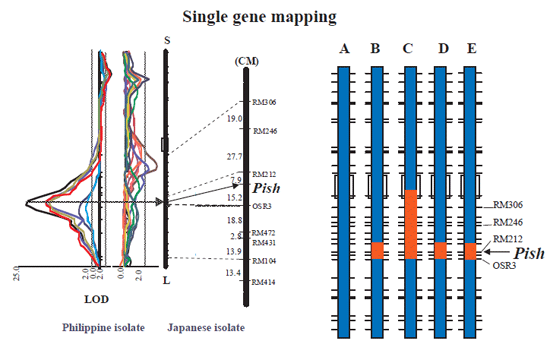The Pish blast resistance gene of rice (Oryza sativa L.) is located on the long arm of chromosome 1
Description
A resistance gene, Pish, to blast disease Pyricularia grisea (Cooke) Sacc. in rice (Oryza sativa L.), was mapped between two DNA markers, RM212 and OSR3, on the long arm of chromosome 1 at the distances of 7.9 and 15.2 cM, respectively.
The blast resistance gene Pish, which shows susceptibility to almost all blast isolates from Japan and moderate resistant to those from the Philippines, was found only in Japonica-type varieties. The location of this unique resistance gene on the rice chromosome has up to now not been identified.
In our analysis using a differential system employing Philippine blast isolates and based on gene-for-gene theory, a Japonica-type rice, Akihikari (AK), showed moderate resistance to almost all blast isolates from the Philippines, and was expected to harbor one of the four genes (Pish, Piz, Piz-5, and Pi9) whose reaction patterns to blast isolates were similar to each other. The reactions of Indica-type rice Milyang23 (M23) was specific to blast isolates but different from those of AK.
Fourteen quantitative trait loci (QTL) for Philippine isolates and 12 QTLs for Japanese isolates were detected in the 14 regions on nine chromosomes (1, 2, 3, 6, 7, 8, 9, 11, and 12) using recombinant inbred lines (RILs) derived from a cross between M23 and AK. Of these, two QTLs on the short arm of chromosome 1 and in the middle of chromosome 6, respectively, showed resistance to Philippine and Japanese blast isolates. The AK allele of the QTL on chromosome 1 and M23 of chromosome 6 showed resistance in each. Yu et al. (1991) reported that the Piz allele is located in the middle of chromosome 6. These results suggest that QTLs on chromosomes 1 and 6 correspond respectively to Pish and one of the Piz alleles.
Detailed mapping of the QTL on chromosome 1 was carried out using a hybrid population of heterogeneous inbred families (HIFs), derived from a M23/AK RIL progeny. The single-gene segregation of the QTL was confirmed in HIFs, and linkage analysis was carried out with eight DNA (simple sequence repeat: SSR) markers. The results mapped QTL (Pish) between the two DNA markers RM212 and OSR3 at the distances of 7.9 and 15.2 cM, respectively (Fig. 1).
The location of Pish was confirmed again using DNA markers and several isogenic lines (NIL), to which had been introduced Pish from Japonica-type donor varieties Kusabue, Shin 2, and BL 1, into an Indica-type rice, CO 39. The graphical genotypes of all NILs showed the introgressions of Japonica-type segments from Japonica donor varieties on the long arm of chromosome 1 (Fig. 2).
This mapping information on Pish is the first to be achieved, and can be utilized for map-based cloning and marker-assisted breeding for blast resistance in rice.
Figure, table
-
Fig. 1. (Left)
Mapping of Pish using QTL analysis and linkage analysis in HIFs on the long arm of chromosome 1.
Left: QTL mapping in M23/AK RILs using blast isolates from the Philippines and Japan.
Right: Localization of Pish in HIFs.Fig. 2. (Right)
Graphical genotypes of chromosome 1 in isogenic lines introgressed with Pish from Japonica-type donor varieties into an Indica-type rice, CO 39.
A: CO39; B: IRBLsh-Ku/CO; C: IRBLsh-S/CO; D: IRBLsh- S/CO; E: IRBLsh-B/CO. Blue and red segments respectively indicate Indica and Japonica-type regions in chromosomes.
- Affiliation
-
Japan International Research Center for Agricultural Sciences Biological Resources Division
- Classification
-
Technical A
- Term of research
-
FY2003(FY1999~2004)
- Responsible researcher
-
FUKUTA Yoshimichi ( International Rice Research Institute )
ARAKI Etsuko ( National Agricultural Research Center for Western Region )
YANORIA Mary Jeanie Telebenco ( International Rice Research Institute )
Ebron Leodegario A. ( International Rice Research Institute )
KHUSH Gurdev G. ( International Rice Research Institute )
- ほか
- Publication, etc.
-
FUKUTA, Y. et al. (1999)Breeding research 1 (Suppl. 1), 38.
Y. Fukuta, M.J.T. Yanoria, L. A. Ebron, D. M. Mercado and G. S. Khush (2001): Genetic and breeding analysis using molecular marker, 22. Reaction pattern of QTL for Philippines blast isolate. Breeding Research 3 (Suppl. 2), 46.
M. J. T. Yanoria, Y. Fukuta, L. A. Ebron, D. M. Mercado and G. S. Khush (2001): QTL analysis for blast resistance using Philippine blast isolates in Rice(Oryza sativa L.). Asian Agriculture Congress Abstract: 267
Y. Fukuta, M. J. T. Yanoria, D. Mercado-Esareta, L. A. Ebron, Y. Fujita, E. Araki, G. S. Khush (2002): Quantitative traits loci (QTL) reactions to rice blast isolates from Japan and Philippines. 3rd International Rice Blast Conference, Abstract, 31.
E. Araki, MJT. Yanoria, LA Ebron, D. Mercado-Escuta, T. Takai, Y. Fukuta (2003): Mapping of a rice blast resistance gene, Pish.Breeding Research, 5 (Suppl.2 ), 333.
- Japanese PDF
-
2004_06_A3_ja.pdf730.14 KB

